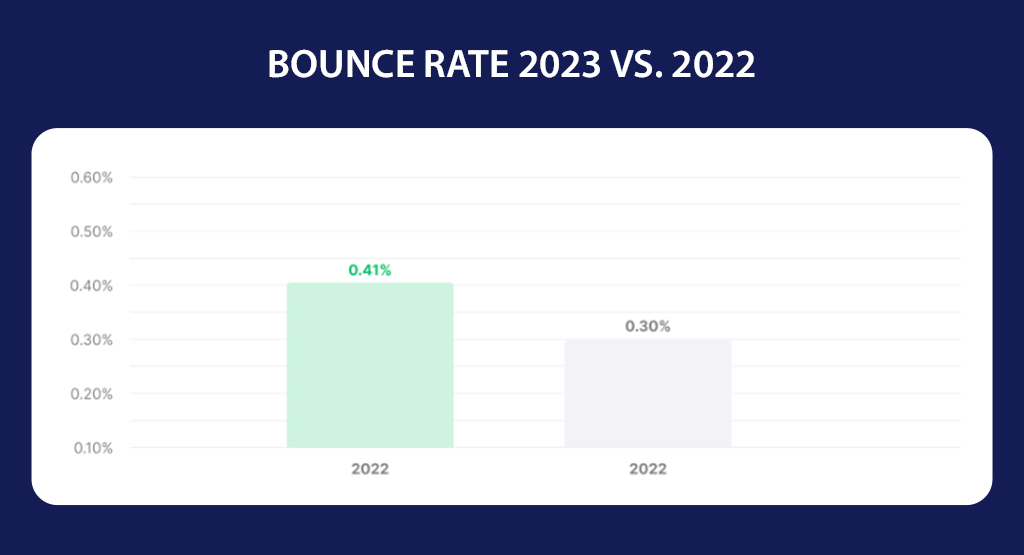Email marketing is a key way for businesses to reach people and get them to take action. But one thing people don’t discuss enough — is how the email bounce rate can ruin the success of your campaign. A ‘bounce’ occurs when the person you sent the email to doesn’t receive it. Keeping email bounce rates low is crucial for maintaining list. The healthy email list, improving deliverability and increasing email marketing ROI.
Imagine you’ve just written the perfect email and are excited to send it out. But then a big chunk of your emails come back to you. That isn’t just annoying — it can seriously eat what you earn from your Email Marketing investment.
What is email bounce rate?
An Email bounce rate signifies how many emails don’t reach the inbox to which you sent them. When you send many emails, you might observe some coming back — indicating a delivery failure. The email bounce rate reveals the percentage of your emails that aren’t reaching their intended recipients. It happens because the email address no longer exists, the receiver’s inbox is full, or another problem stops delivery. Knowing this number is key to seeing if your emails are working. A high bounce rate may signal issues with email content or delivery, hindering message effectiveness.
Why are email bounce rates so important in email marketing?
The importance of Email bounce rates lies in their role as a gauge of how well your email marketing is doing. Get a clearer view of how good your email list is and how well your emails are being delivered. Keep an eye on and control your bounce rates to fine-tune your email marketing efforts and boost your profits.

The Value of Email Verification In Email Marketing
What is email verification in email marketing?
Email verification checks if the email addresses on your list are correct, and you can get emails. It ensures they’re written right, looks to see if the email domains are real, and finds any spam traps or bad addresses. A handy trick for businesses and people to cut down on bounced emails is email verification. Email verification ensures working emails on your list to avoid bounces and boost email marketing.
Try Our Free Email Validation Checker Tool
How email bounce rates affect email marketing ROI
If too many emails bounce back, it’s bad news for your email marketing ROI. It means you need to reach your target audience. It would help if you had more time and opportunities, and your connection with potential customers is dropping. If you cut down on bounces, your email campaigns could work better and earn you more money.
Did you know the world’s average email bounce rate is about 2.4%? Yet, this number changes across different fields, with some industries seeing bigger bounce rates.
Re-engagement Strategy for High Bounce Rate Lists
Having a high bounce rate list means you’ve got to get your act together with strategies to keep your list quality up. Try sending ‘come back’ emails to folks who aren’t responding anymore, and maybe throw in a little something to make them want to give you their new email or sign back up. It’s also key to stop sending emails that keep bouncing. There’s also a tie between bounce rates and how often people do what your emails ask.
Big bounce rates might show deeper problems affecting how well your email campaigns do their job. Looking at this tie can hint at what needs fixing so that you can boost the number of people taking action. Improving bounce rates won’t instantly get you more sales, but it’s a big part of making your campaigns run smoother and get better outcomes.
Read: Securing Your Inbox: The Importance of Email Authentication
Email bounce rates matter a lot because they affect how well your email marketing does. When you get what bounce rates do, use top methods and closely monitor things to get better. You’ll make sure more of your emails are delivered. It means more people engage with them, and you get more for the money you spend.
Benefits of using our free bulk email verifier online
Email verification keeps your email list clean and high-quality. When you remove bad or unused emails, you’re less likely to have bounced, so your emails get seen more. That means you’ll engage better with your audience, which could lead to better returns from your email marketing.
Imagine a tool that weeds out the dud emails and freshens your list with correct info. Here’s where myEmailVerifier comes in. It helps businesses drop their bounce rates by removing dead-end emails. You get perks like looking good as an email sender, more emails reaching inboxes, and a leg up in business.
- Top-notch Deliverability: When you send emails to the wrong or unused addresses, it can trash your sender’s reputation and make your emails look like spam. Cleaning up your list with verification prevents this and keeps your successful delivery rates high.
- Bounce Rate Minimization: Email bounces because the address is off or something else went wrong, and too many bounces don’t look good.
- Problems with Delivery: Checking your email list can reduce the number of emails that bounce and help ensure they get to the right people.
- Improved Reputation for Sending: When a list is cleaned and checked for correct email addresses, it tells email service providers that you’re a legitimate sender. They’ll trust your messages more, which means they’re more likely to end up in the inbox instead of the spam folder.
- Better ROI: By cutting out bad email addresses, you can aim your email marketing at people more likely to pay attention and interact. It might lead to more people opening emails, clicking on links, and, ultimately, a stronger return on investment (ROI) for your email drives.
Conclusion
To wrap it up, keeping the number of bounced emails low is key for nailing your email marketing game. Grasp why emails bounce, check the validity of email addresses you’re sending to, and monitor how often they get kicked back. Improving these areas will help your emails land where they should, keep your mailing list in shape, and crank up returns on what you spend in email marketing. Stay sharp with the latest trends and tricks, and fine-tune your approach to make sure as many people as possible are checking out what you send. Email bounce rate management should be top shelf in your marketing toolkit for reaching more folks and winning them over.
FAQs About Email Bounce Rates
What’s a good number for an email bounce rate?
A bounce rate between 2% and 5% will be fine with your day. Still, “good” can change based on your scene, who you talk to, and the vibe of your emails. Keep tabs on your rates vs. everyone else’s to see if you’re on the ball or dropping it when it comes to keeping emails from bouncing.
How do I reduce email bounce rates?
Are they feeling fed up with too many emails missing their mark? Here’s how to fix it: – Ensure you only send stuff to real-deal email addresses through email verification. – Tidy up that subscriber list now and then. – Confirm people want in with a second thumbs-up when they sign up. – Design emails smartly—ditch words that’ll send you straight to spam. – Bust up your list; not all followers are the same. – Get the 411 on why emails are bounced and fix whatever’s throwing them off course.
Will lots of bounces affect email deliverability?
Yes indeed. If you’re racking up bounces, internet gatekeepers (like ISPs & email platforms) start giving you the side-eye. They think high bounces mean something fishy, which may result in fewer of your emails making it to inboxes. Keep those numbers down so you stay looking good in the digital realm.
Keeping an eye on your email list quality and your reputation as a sender is crucial. If you find that your bounce rates are always high, there’s a risk that your emails might be tagged as spam or could even be blocked. This situation can seriously interfere with your chance to get into your subscribers’ inboxes, harming the success of your email marketing efforts.
James P. is Digital Marketing Executive at MyEmailVerifier. He is an expert in Content Writing, Inbound marketing, and lead generation. James’s passion for learning about people led her to a career in marketing and social media, with an emphasis on his content creation.
